Ancient Roman Beach in Herculaneum Reopened: A Step Back in Time
The ancient beach of Herculaneum has been meticulously restored and reopened to the public, offering a unique glimpse into Roman history.
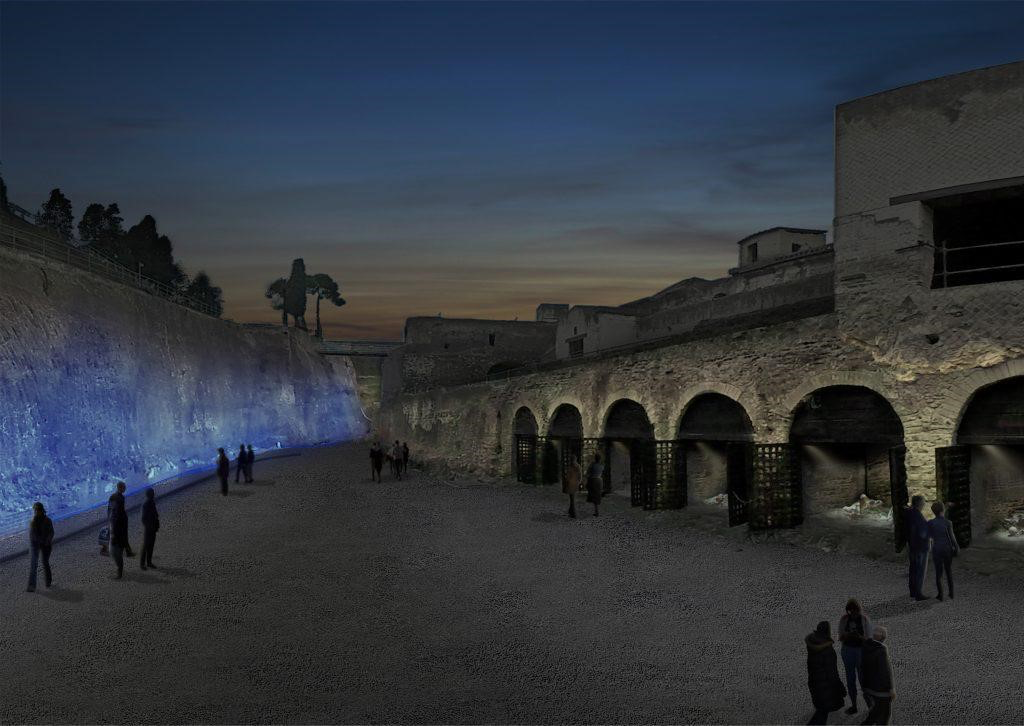
The Italian Ministry of Culture has announced the reopening of the ancient beach of Herculaneum, marking a significant milestone in the preservation of Roman history. This landmark event not only unveils a site rich in historical and cultural value but also demonstrates the collaborative efforts of public and private entities dedicated to heritage conservation.
Unveiling the Ancient Beach: A Historic Event
On June 19, 2024, the ancient beach of Herculaneum was reopened to the public, a first within an archaeological park. The event was graced by the presence of the Italian Minister of Culture, Gennaro Sangiuliano, who was guided through the newly restored site by Francesco Sirano, Director of the Archaeological Park of Herculaneum.
This reopening culminates years of multidisciplinary research, excavation, restoration, and engineering, all aimed at bringing the beach as close as possible to its pre-eruption state, and removes the spotlight from the recent defacing event from a reckless tourist. Herculaneum, a coastal city devastated by the eruption of Mount Vesuvius in 79 AD, now offers visitors a unique opportunity to walk on its ancient shores, experiencing the city as it once was.
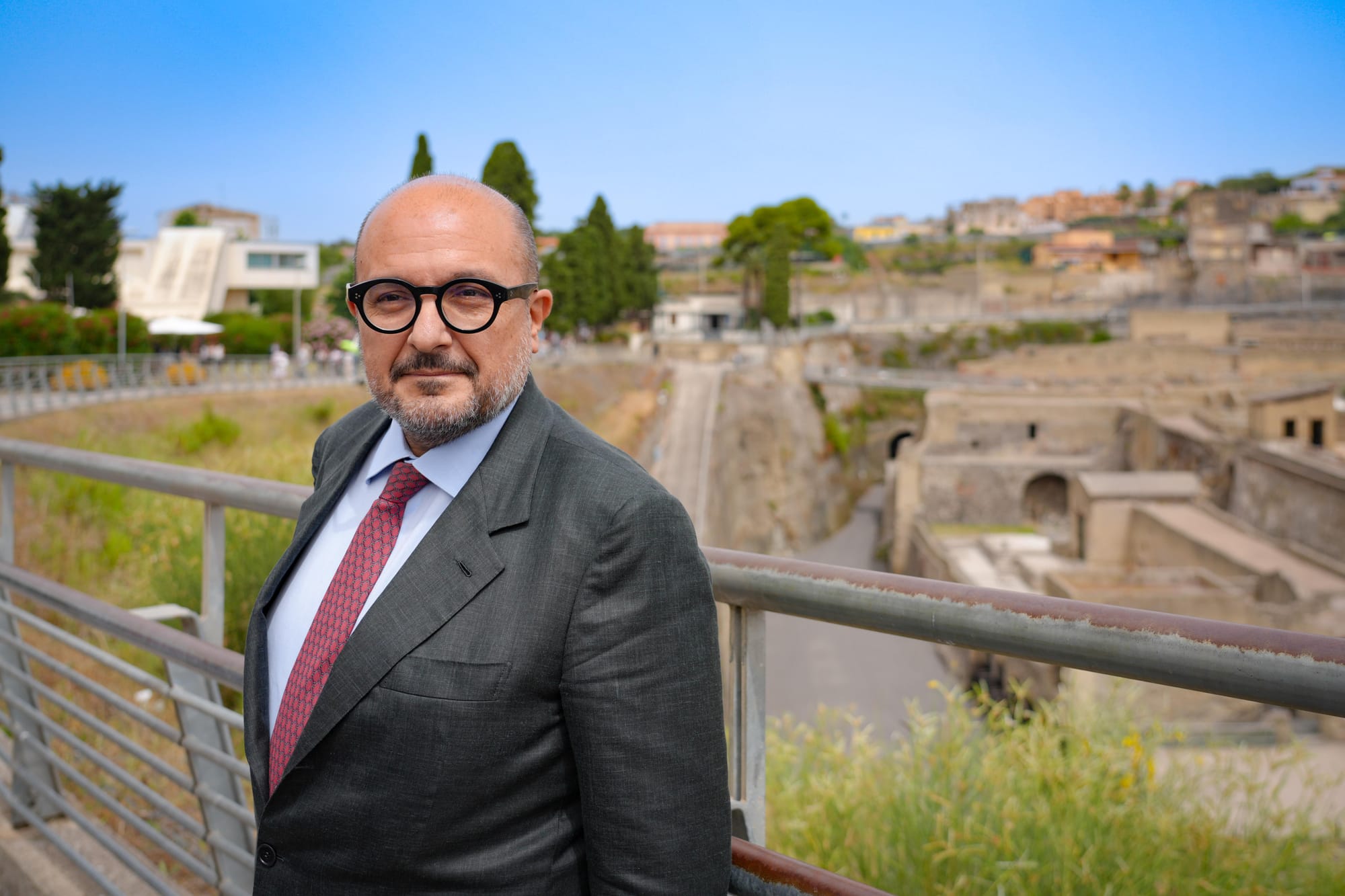
Significance of Herculaneum in Ancient Rome
Herculaneum, like its more famous neighbor Pompeii, was a vibrant Roman city that met its end during the catastrophic eruption of Vesuvius, as described vividly by Pliny the Younger. Unlike Pompeii, which was buried in ash, Herculaneum was engulfed by pyroclastic flows, which preserved wooden structures, food, and other organic materials in remarkable detail. This preservation offers an unparalleled glimpse into Roman life, urban planning, and architecture.
The beach, a vital part of Herculaneum's daily life and economy, served not only as a site for leisure but also as a crucial point for trade and transportation. The meticulous restoration of this area is therefore not just about reviving a physical space but about reconnecting with the social and economic heartbeat of the ancient city.
Official Statements: Commitment to Heritage Preservation
Minister of Culture Gennaro Sangiuliano emphasized the project's cultural and economic importance, stating,
“This site has been enormously rehabilitated and is becoming a gem. We are within one of the most important archaeological areas in the world, along with Pompeii and Oplontis, and we are working extensively, including in terms of resources. In the budget law, we allocated new resources for the excavations. Moreover, we planned that a museum hub would be established in the Spolettificio of Torre Annunziata, which we believe can also represent a great opportunity for socio-economic development for our territories.”
General B. Giovanni Capasso, Director General of the Grande Pompei Unit, added,
“The CIS Vesuvio Pompei Napoli represents the instrument identified by the legislator for implementing the strategic plan for developing the areas included in the UNESCO site management plan 829 ‘Archaeological areas of Pompeii, Herculaneum, and Torre Annunziata,’ updated and approved by the Management Committee in 2022.”
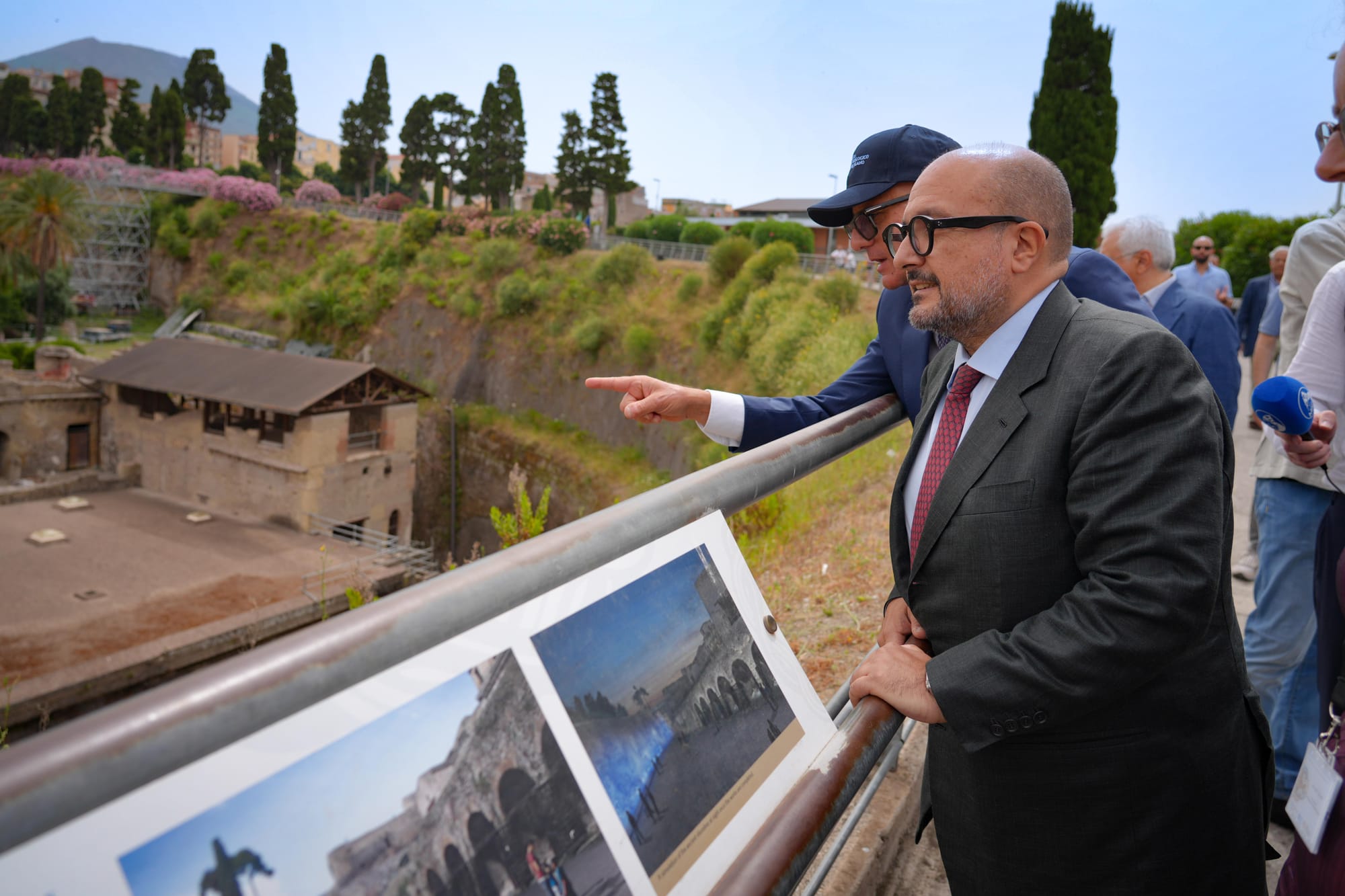
Restoration Efforts and Future Plans
The restoration of Herculaneum’s beach was a complex endeavor, necessitated by decades of natural erosion and environmental damage. The project adopted a multidisciplinary approach to ensure the site's safety and accessibility, transforming it from a marshy hazard into a walkable, evocative landscape.
The overarching goal of this project extends beyond the beach. It aims to enhance the visitor experience and foster a deeper understanding of the ancient city’s layout and history. This effort includes reconnecting the main archaeological area with the Villa of the Papyri, a grand Roman residence famous for its extensive library of charred scrolls.
Jane Thompson, who oversees the public-private partnership with the Packard Humanities Institute, highlighted the project’s significance:
“Seeing this transformation of the ancient city's seafront area completed is an immense satisfaction for the rich interdisciplinary team that brought it to fruition, both the professionals appointed by the Packard Humanities Institute foundation and the MIC officials.”
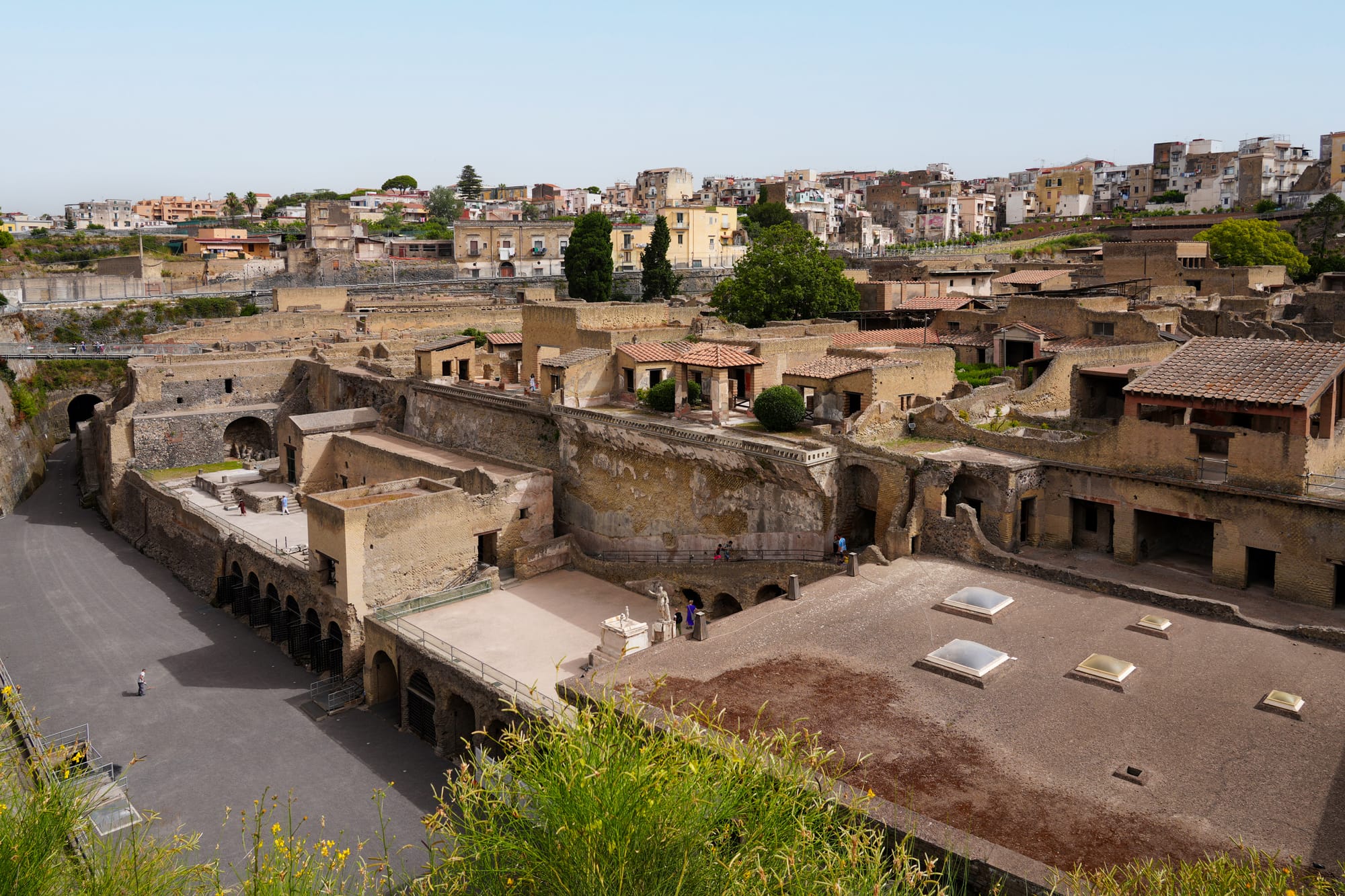
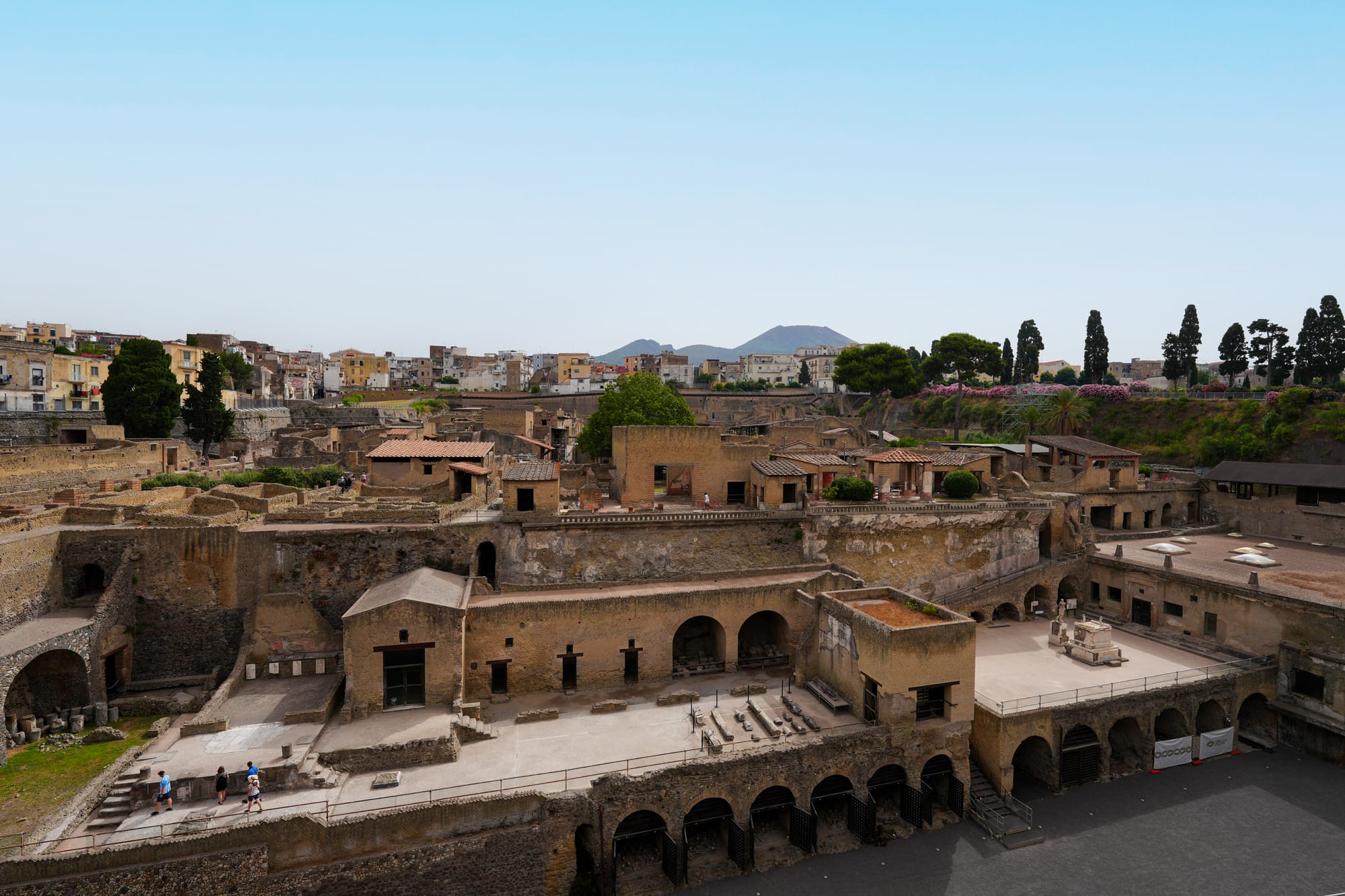
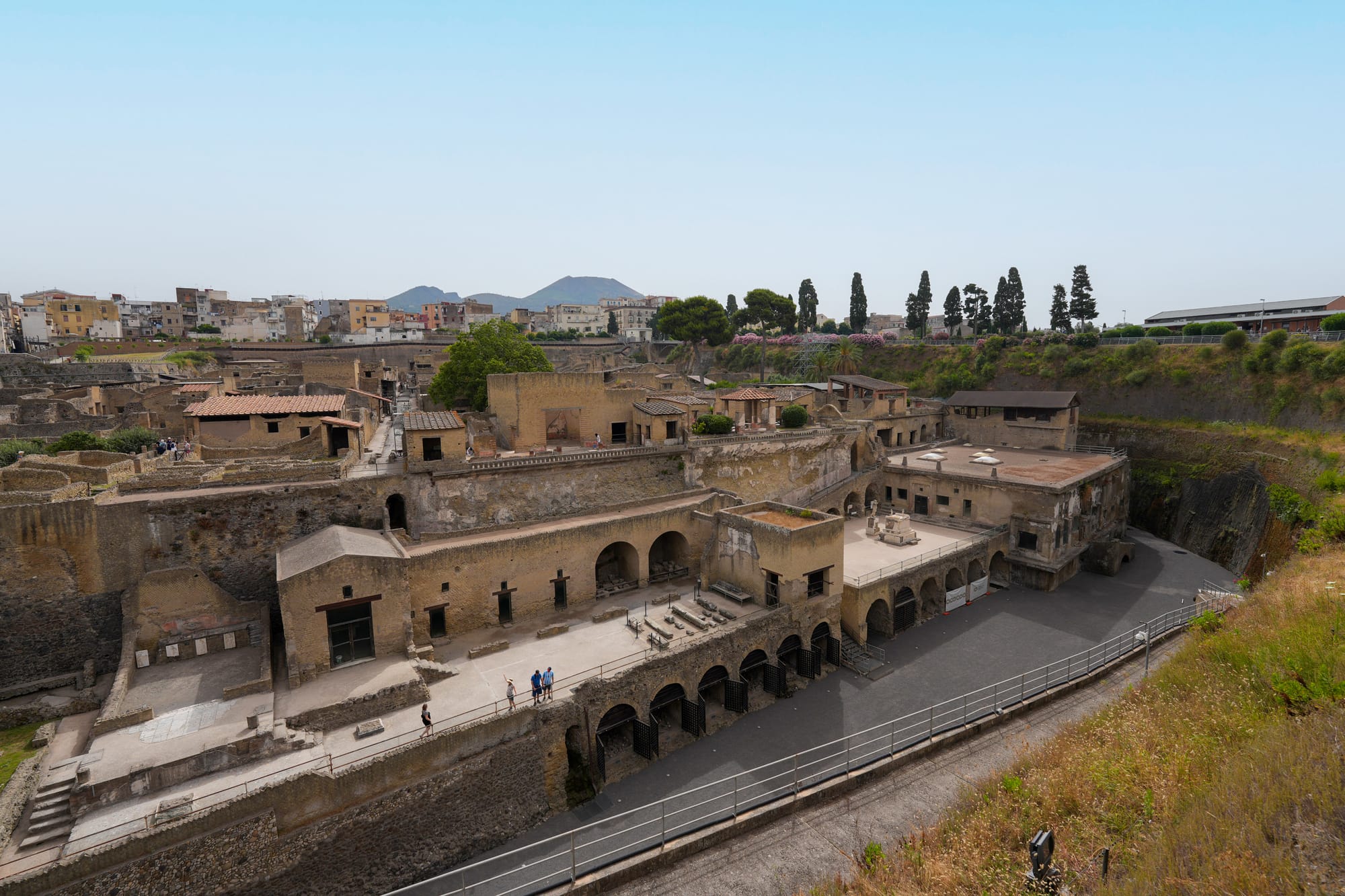
The Herculaneum Beach Site. Credits: Emanuele Antonio Minerva ‐ Ministero della Cultura
The Ancient Beach: A Narrative Etched in Sand
Photographic evidence from the 1990s excavations shows a tuff platform with parallel incisions, likely made by boat keels. Over centuries, the coastline’s level changed multiple times due to volcanic activity, shaping the beach into the black volcanic sand shore of 79 AD. This beach, inclined towards the sea, was crucial for maritime activities and urban access, with ramps leading to houses and supplying wood to the city’s baths.
During the catastrophic night of the eruption, over 300 people and animals, including mules and horses, perished on the beach. The first pyroclastic surge, with temperatures over 400°C and speeds of 80 km/h, caused instantaneous death. Subsequent volcanic mudflows buried their remains. These skeletons provide invaluable insights into the diet and health of Herculaneum's ancient inhabitants. They carried valuable items like coins, jewelry, lamps, and house keys, suggesting they had time to close their homes before fleeing.
In late 2021, the discovery of a man’s skeleton, along with a fabric bag containing a wooden coin holder and writing tablets, further enriched this narrative. The site also revealed numerous wooden artifacts, from shrubs and tree roots to beams and boat fragments, underscoring Herculaneum's unique archaeological significance.
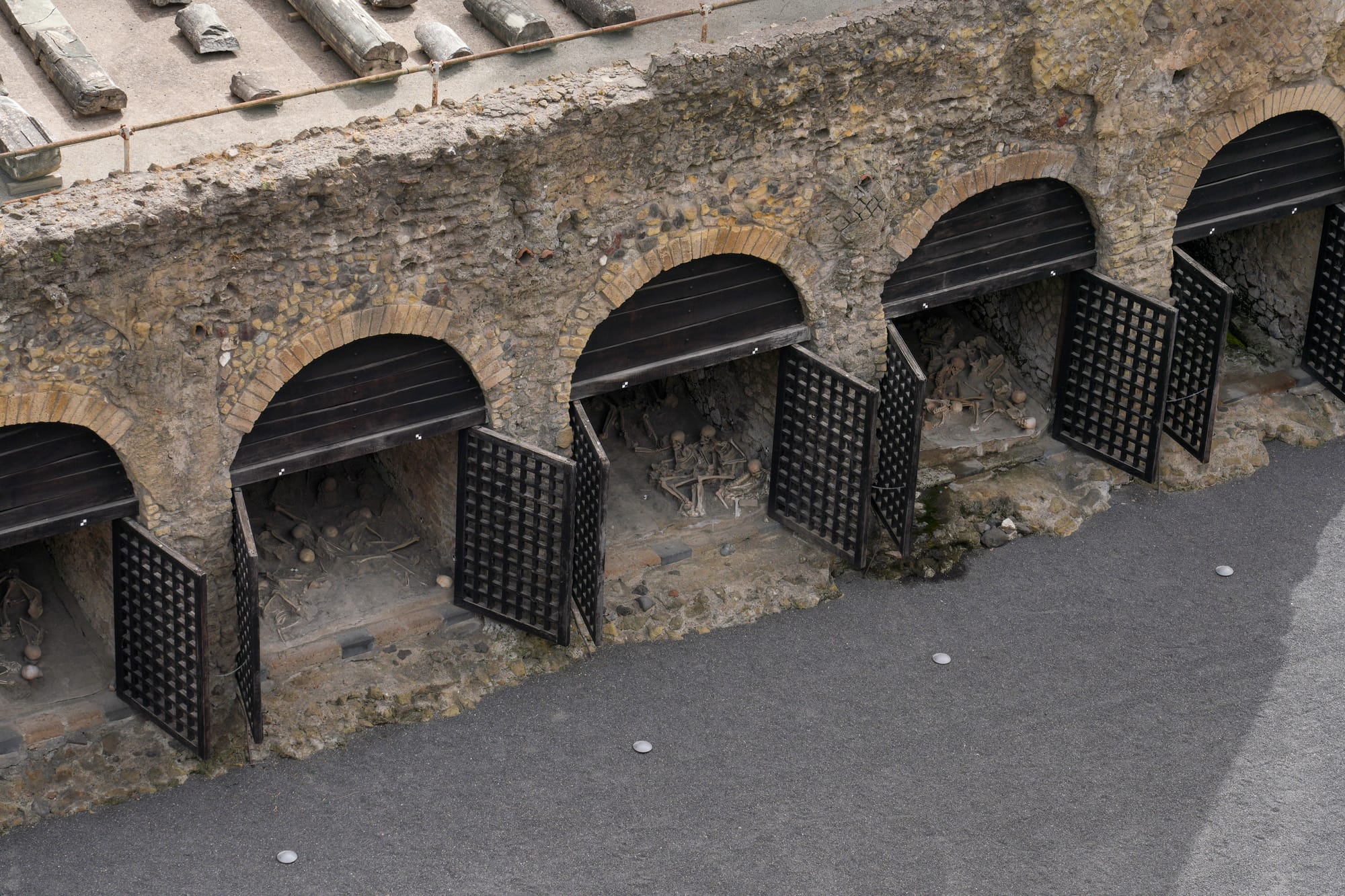
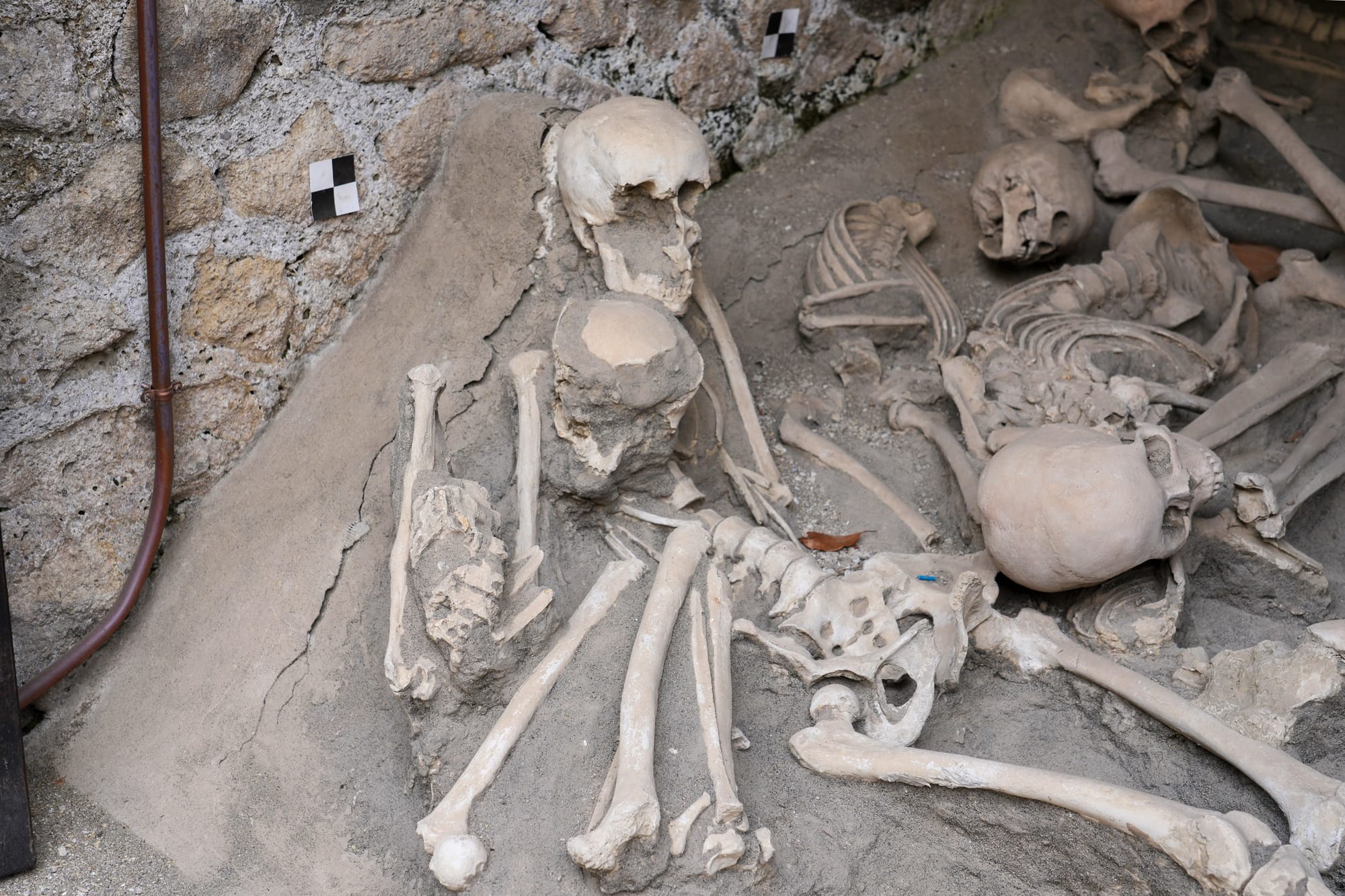
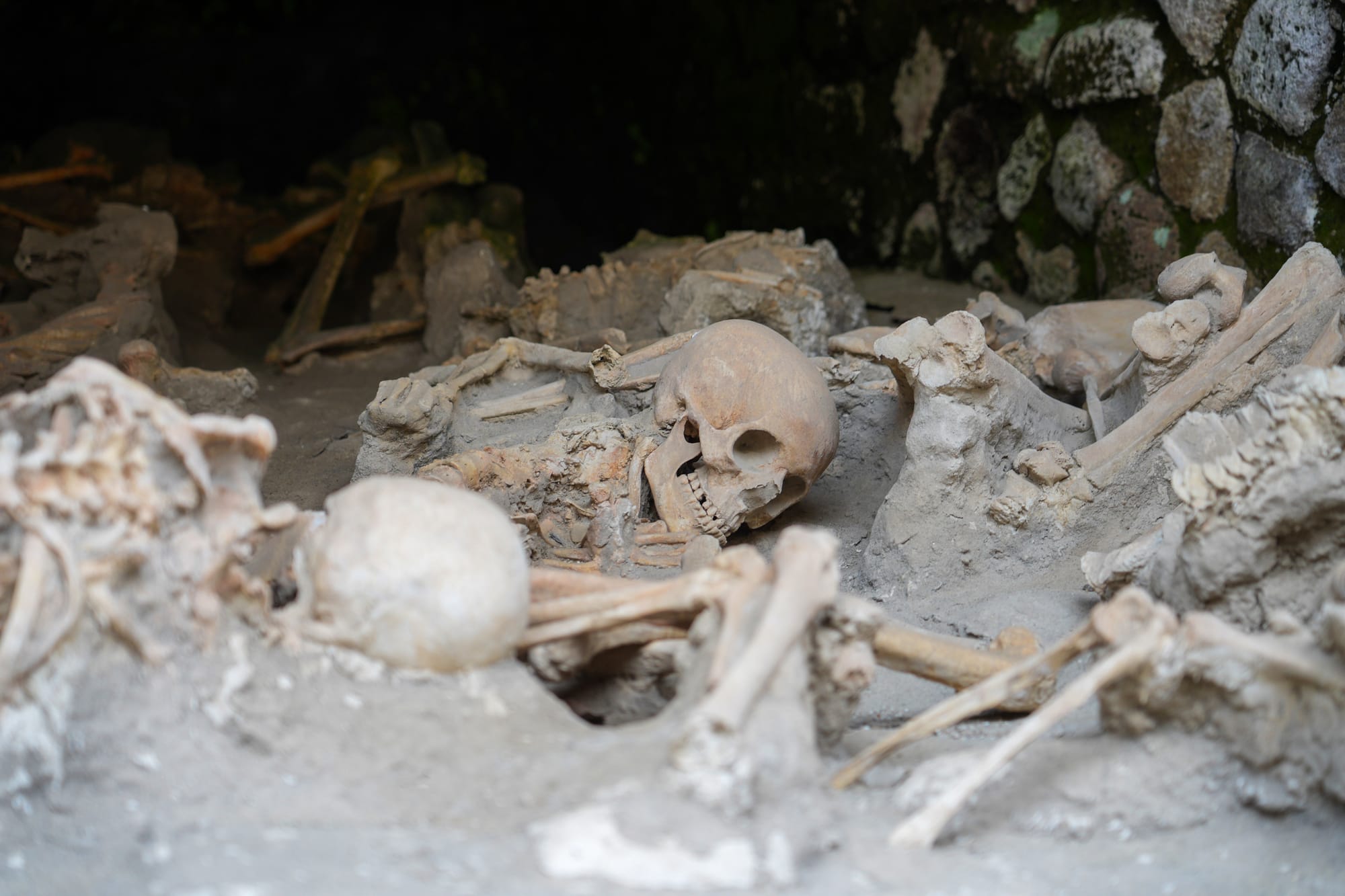
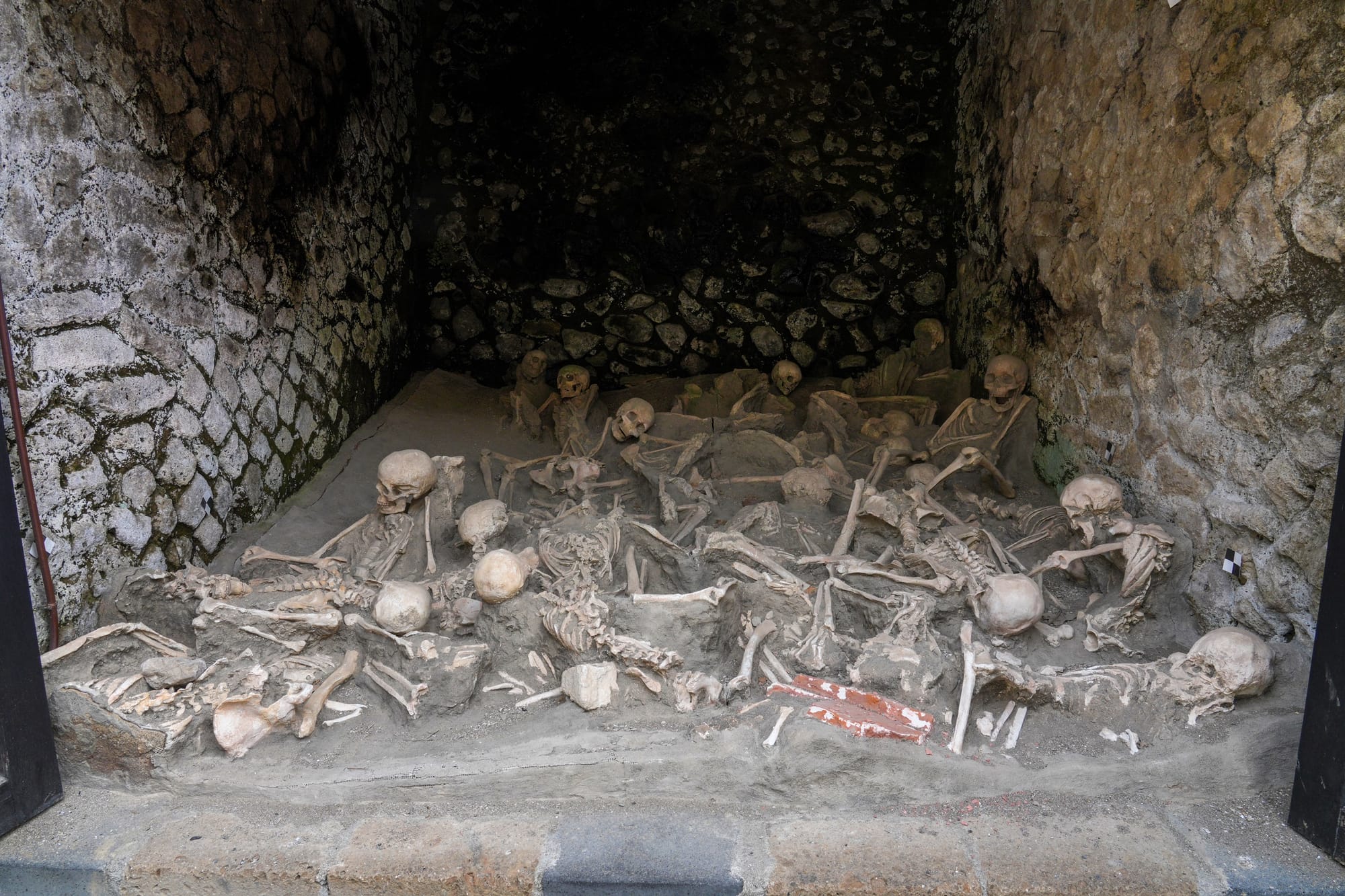
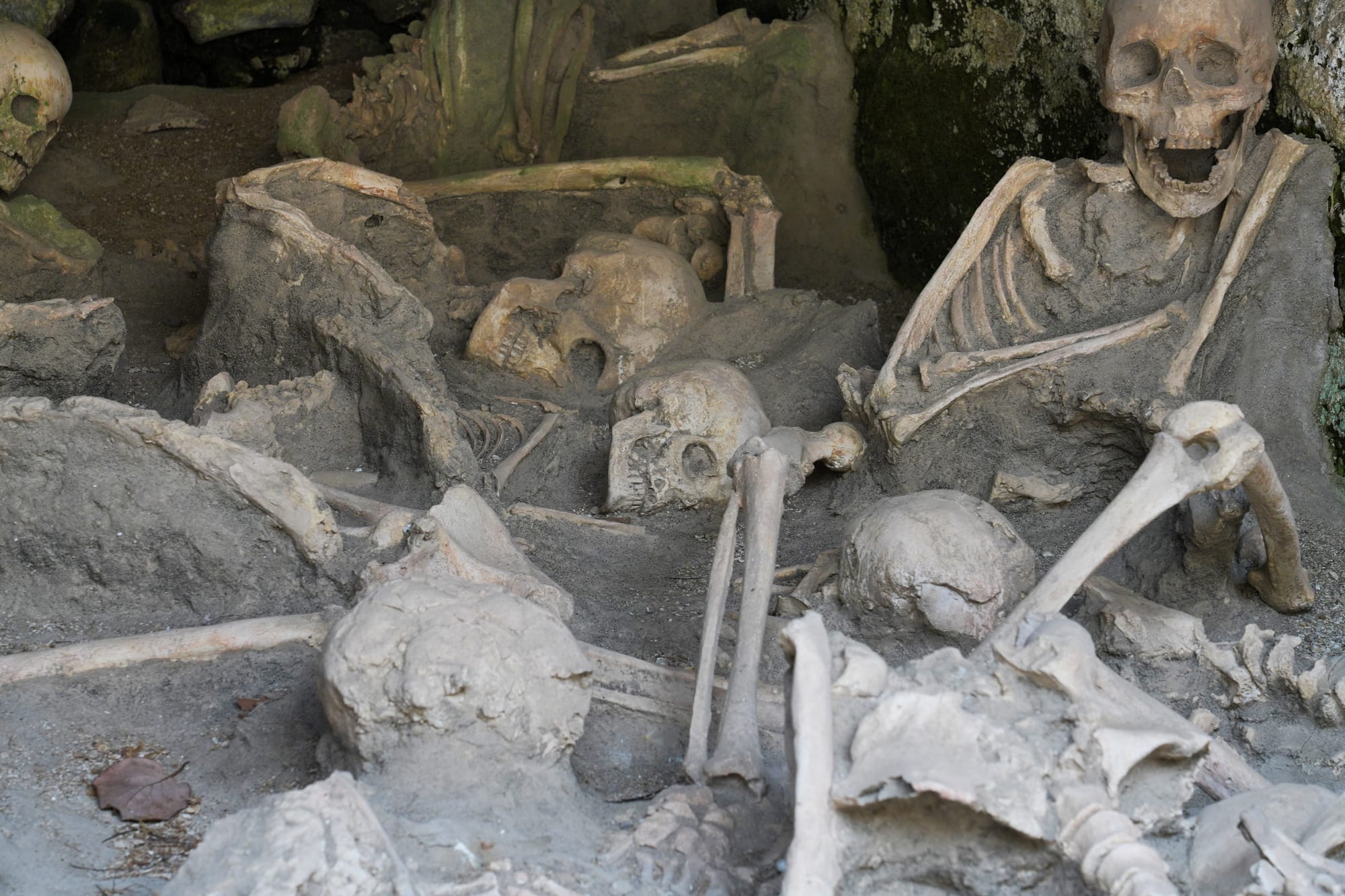
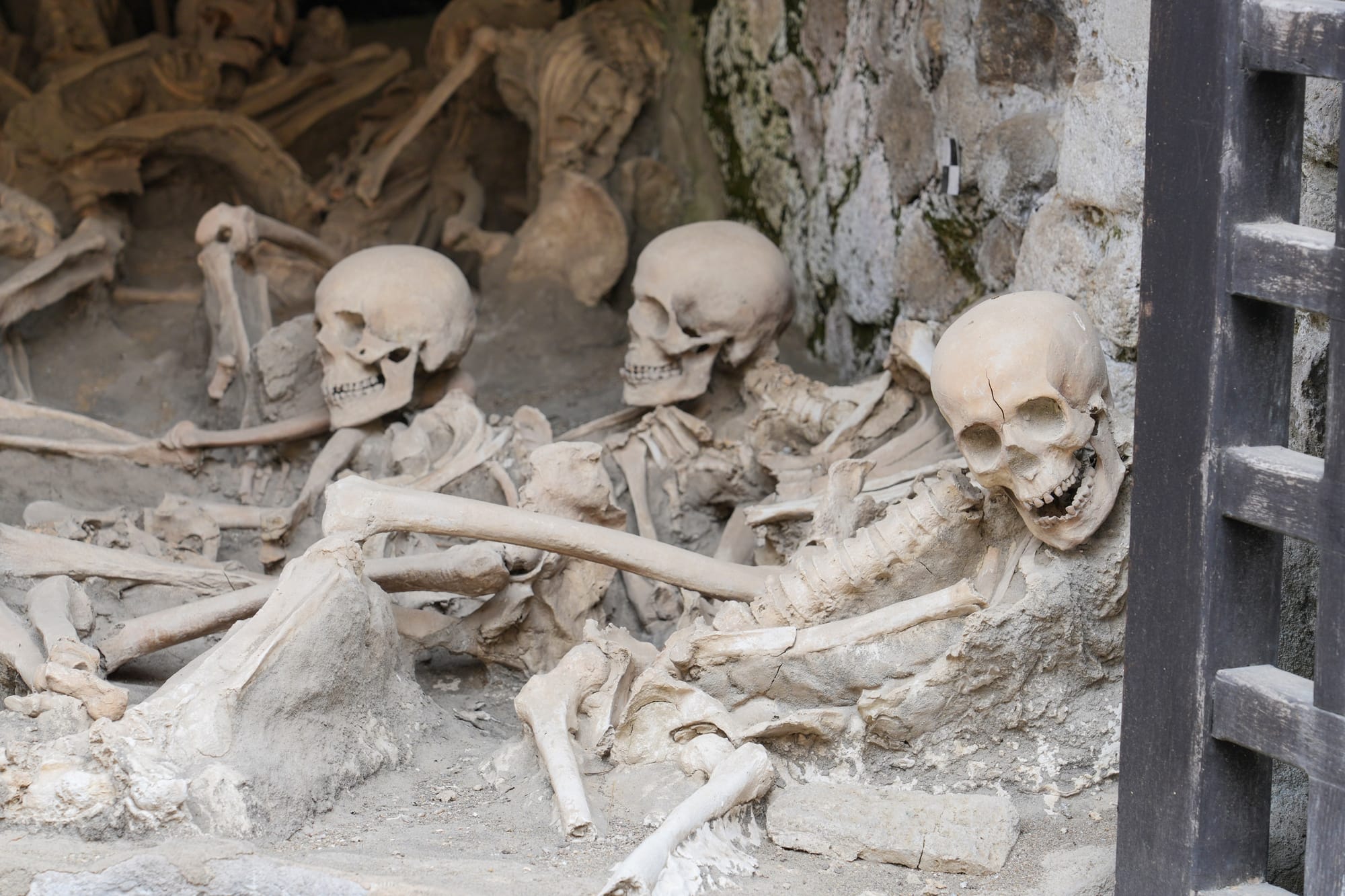
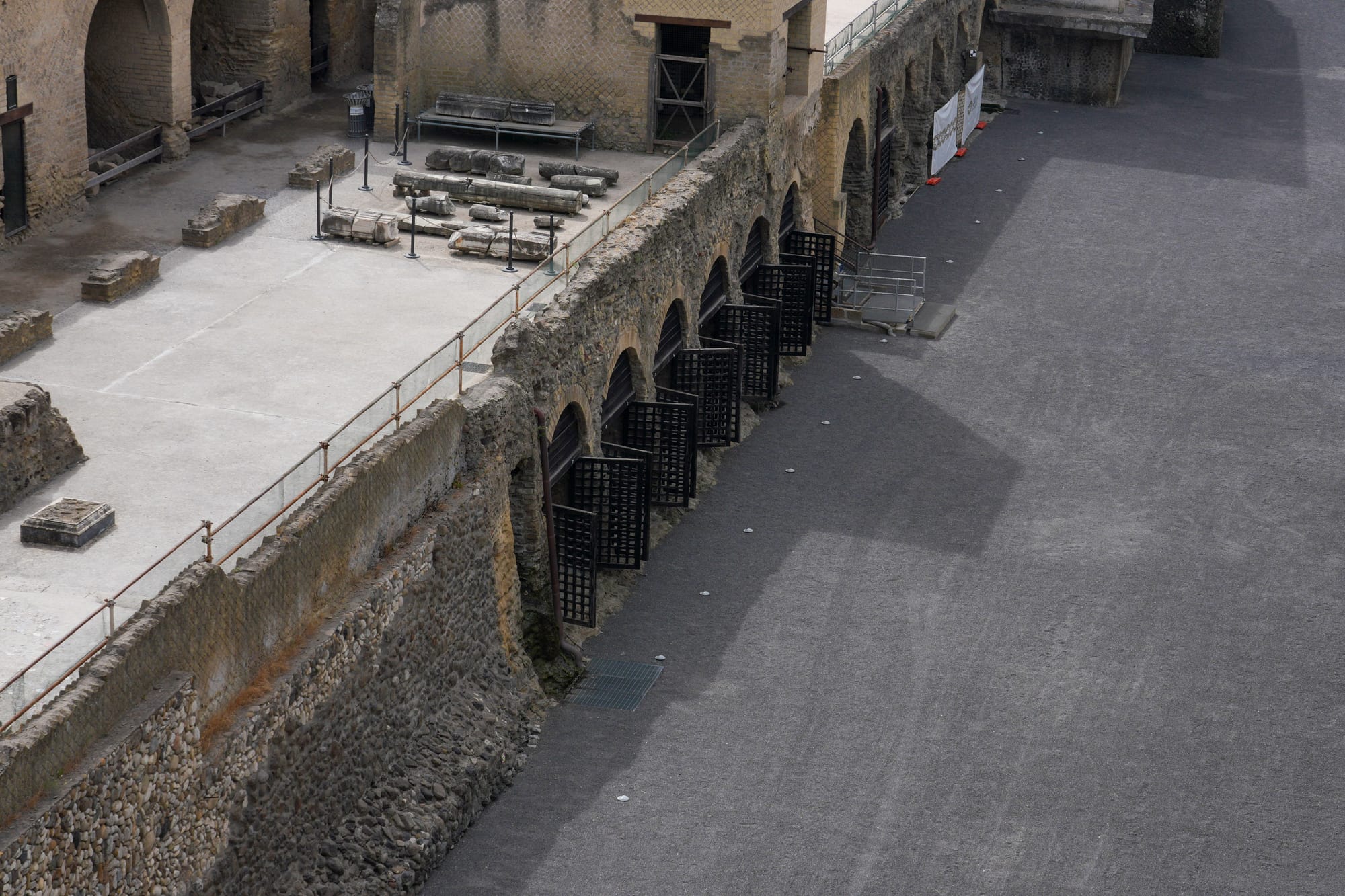
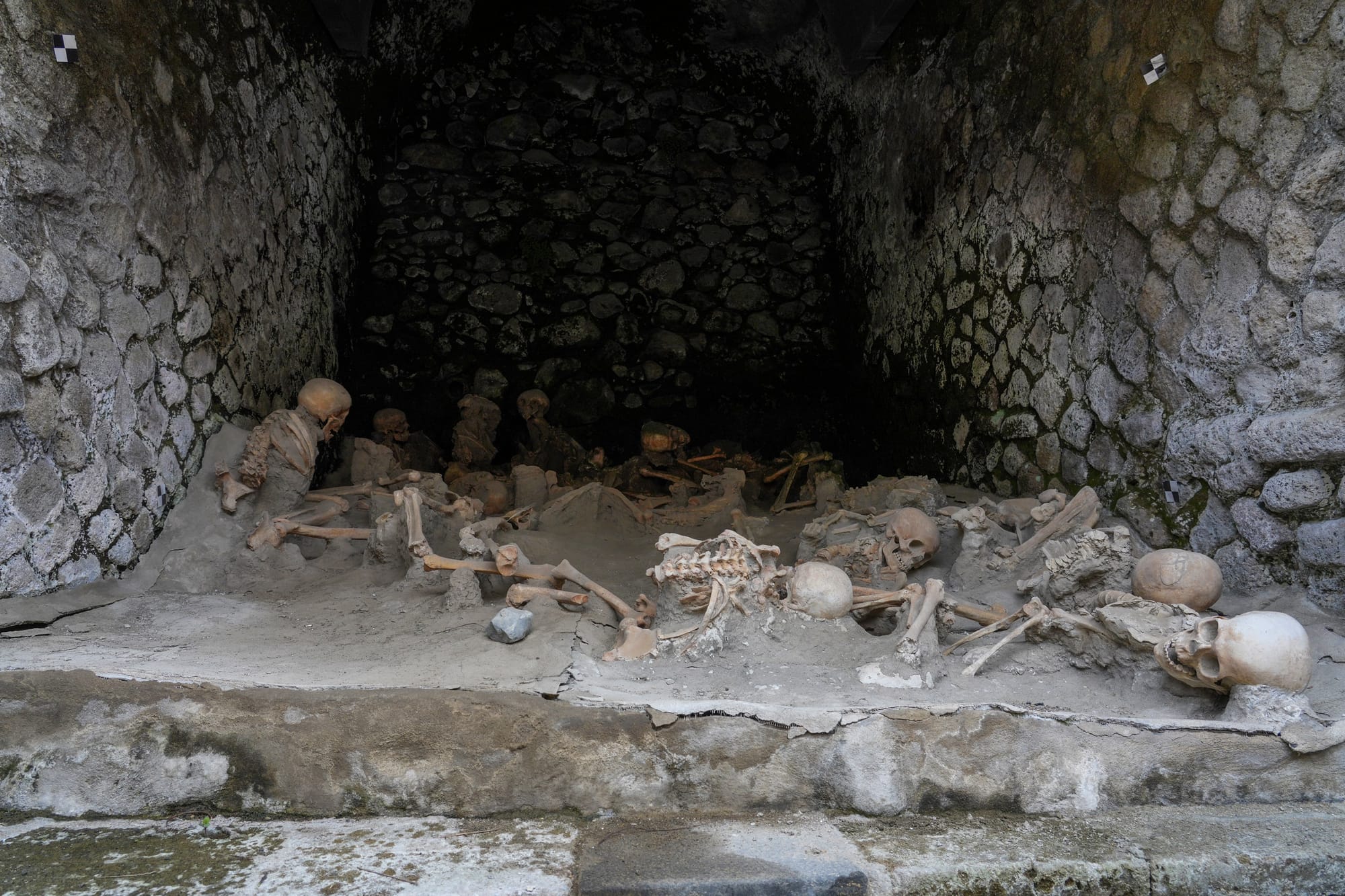
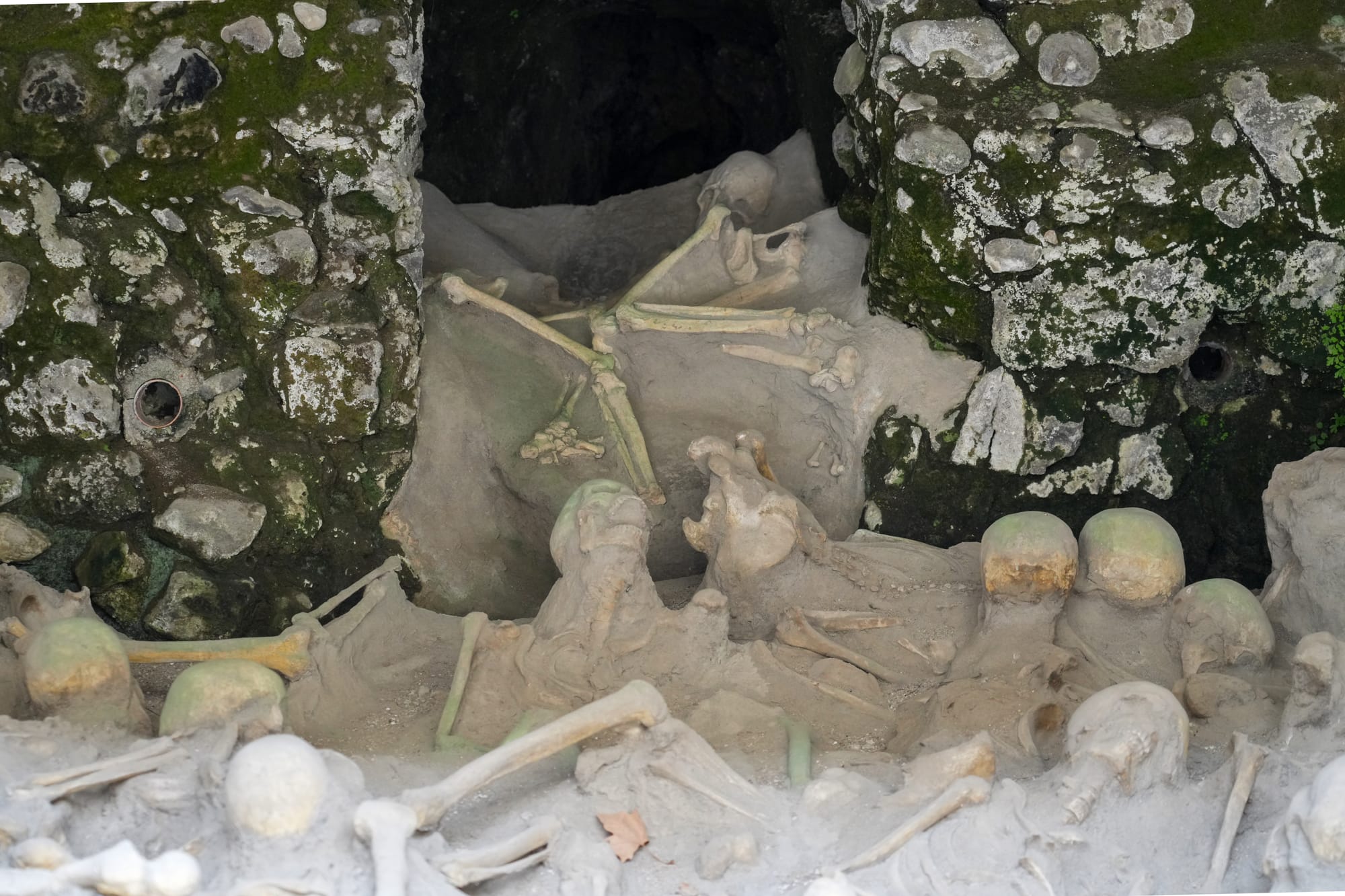
The Herculaneum Beach Skeletons. Credits: Emanuele Antonio Minerva ‐ Ministero della Cultura
The Last Fugitive of Herculaneum and His Belongings
In late 2021, the ancient beach of Herculaneum yielded the skeleton of its last known fugitive. This robustly built man, estimated to be 40-45 years old, was discovered at the seashore or possibly thrown from a nearby terrace.
When the pyroclastic flow from Mount Vesuvius hit, he was standing, facing the city, and likely saw the deadly ash cloud approaching. The heat instantly vaporized his tissues, leaving his skeleton encased in volcanic debris. This grim discovery mirrors the fate of over 300 others found previously.
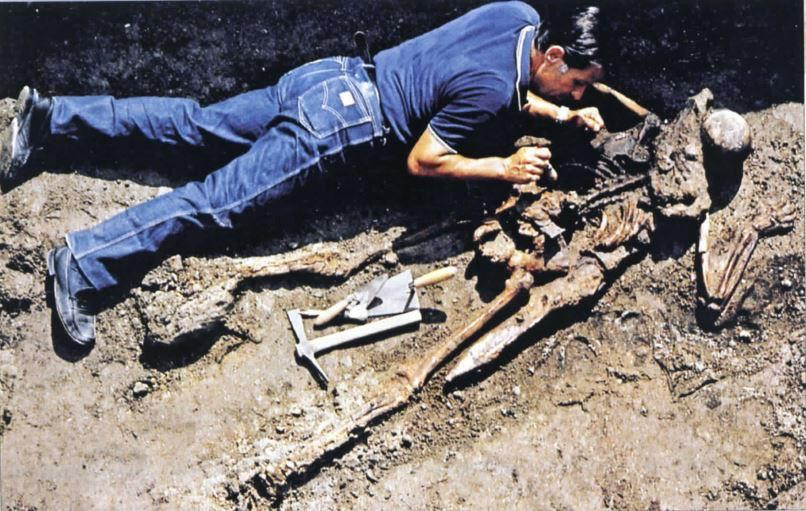
A Comprehensive Conservation Strategy
The restoration of Herculaneum’s beach is part of a broader conservation strategy spearheaded by the Herculaneum Conservation Project, a collaboration between the Italian government and the Packard Humanities Institute. This initiative, which began in the early 2000s, has focused on stabilizing and preserving the site through innovative, multidisciplinary approaches.
One of the critical challenges was managing the site's complex water issues. Natural spring waters and ancient sewage systems, still in use, had caused repeated flooding, threatening the stability of the archaeological remains. The restoration project has successfully addressed these issues, ensuring that the beach and surrounding areas are now secure and accessible.
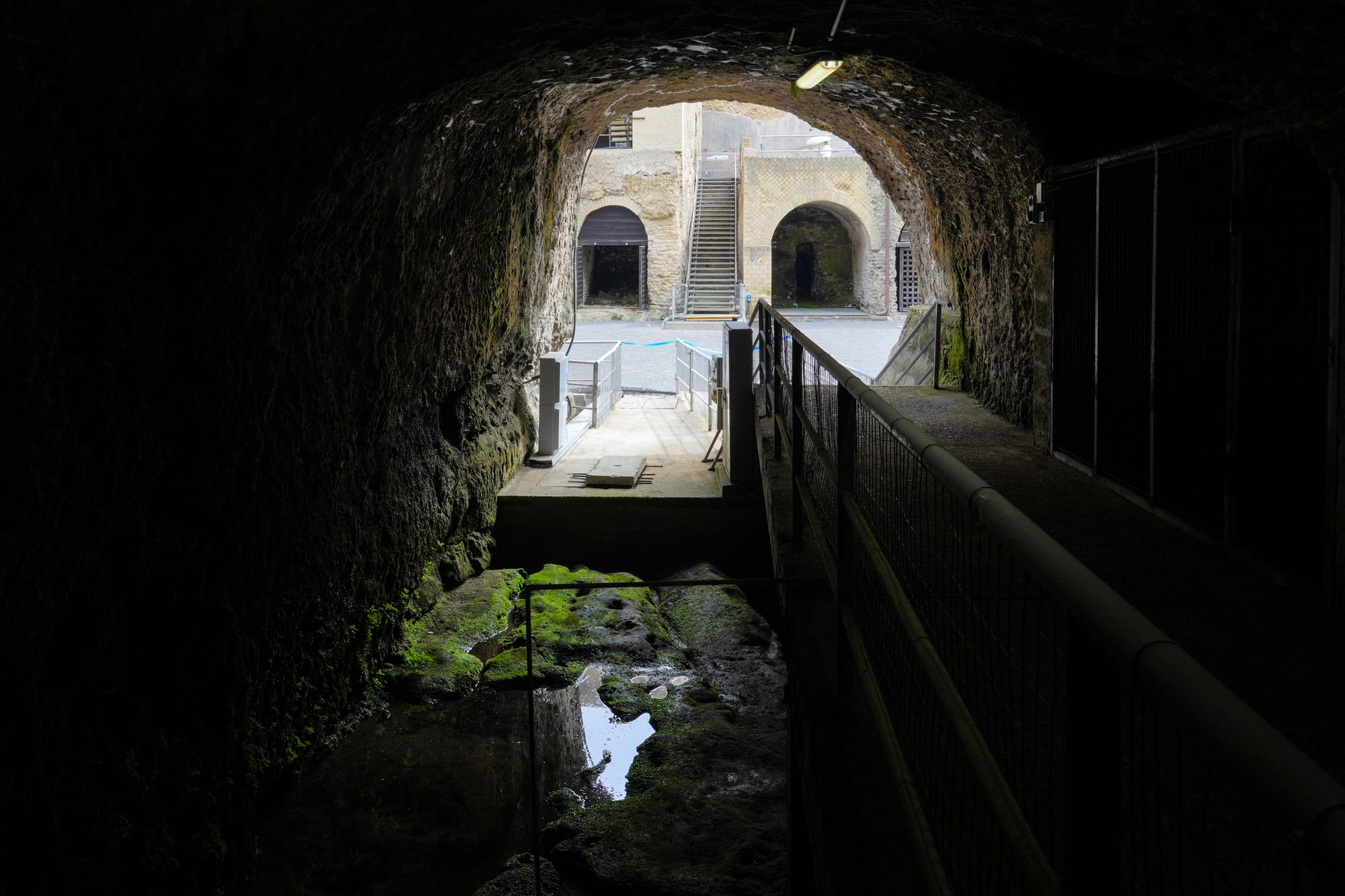
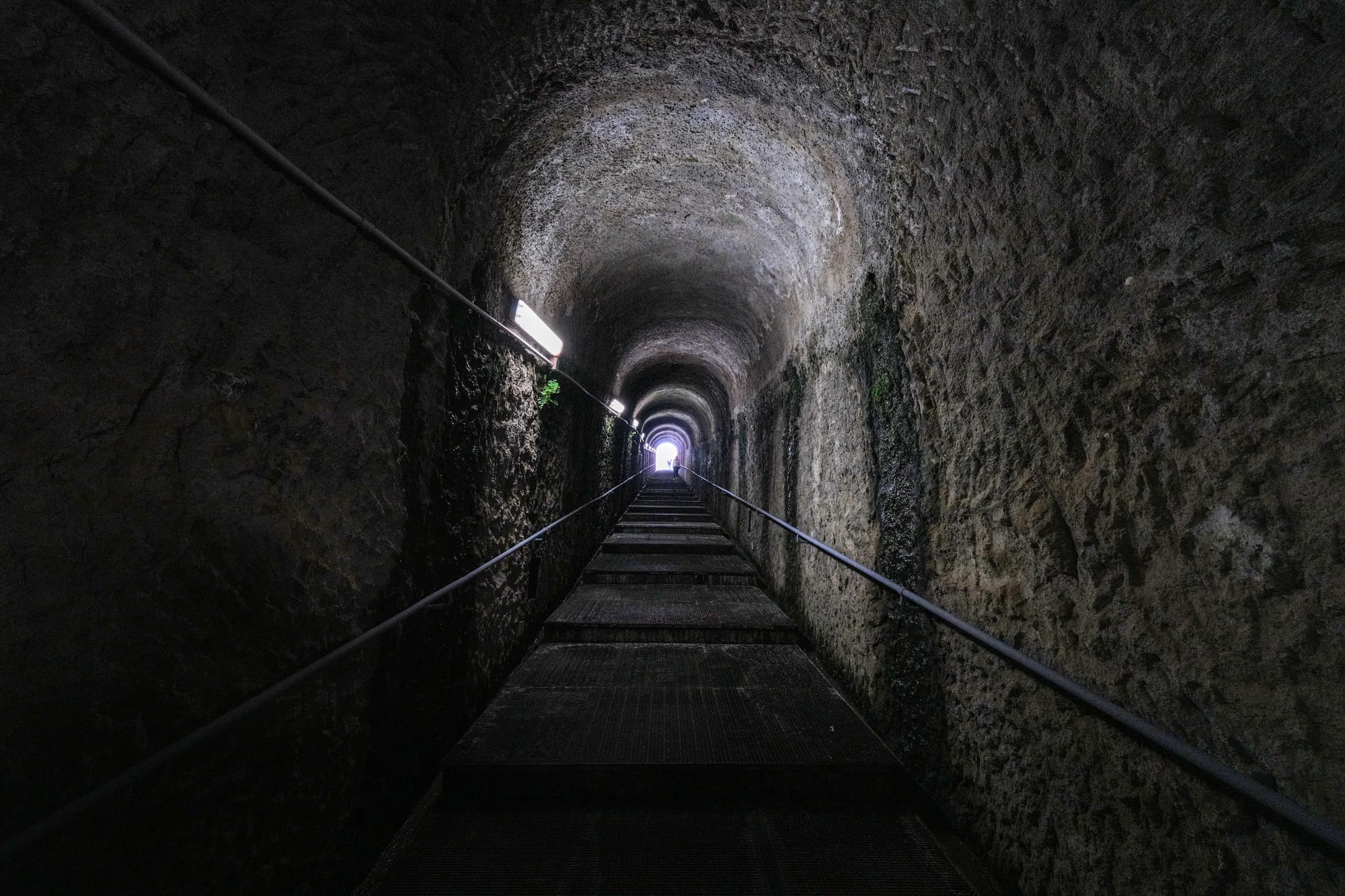
The Herculaneum Beach Water Sewage Restoration. Credits: Emanuele Antonio Minerva ‐ Ministero della Cultura
Project Overview: Restoring the Ancient Beach
The recent restoration project at Herculaneum controls natural spring water and ancient sewage outflows, which once turned the area into a marsh. Now, these waters are managed and partially reused, stabilizing the excavation sites and transforming the beach into its pre-eruption state. Before the project, the beach was an inaccessible marsh, but thorough research and pilot projects from 2008 to 2010 laid the groundwork for its revival. Hydraulic works now ensure proper water management, reactivating original sewers and preventing flooding.
Since 2011, extensive archaeological studies have revealed the ancient beach's history, with limited excavations beginning in April 2021. These efforts uncovered remnants of ancient sand and confirmed that the coast was originally covered with a sand layer. The beach’s new surface, made of stabilized basalt grit, is accessible to visitors and maintenance vehicles, maintaining historical accuracy while providing modern convenience.
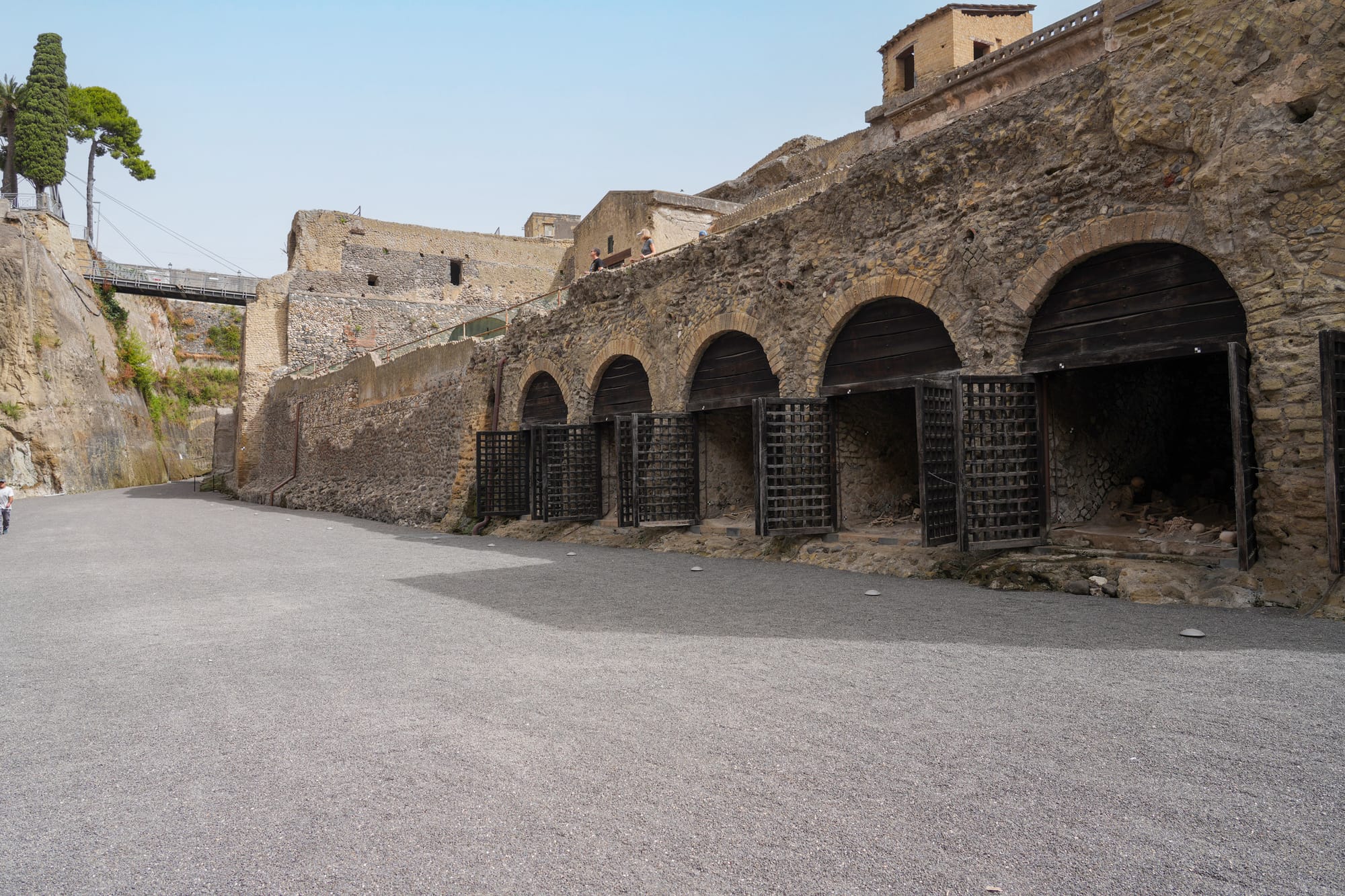
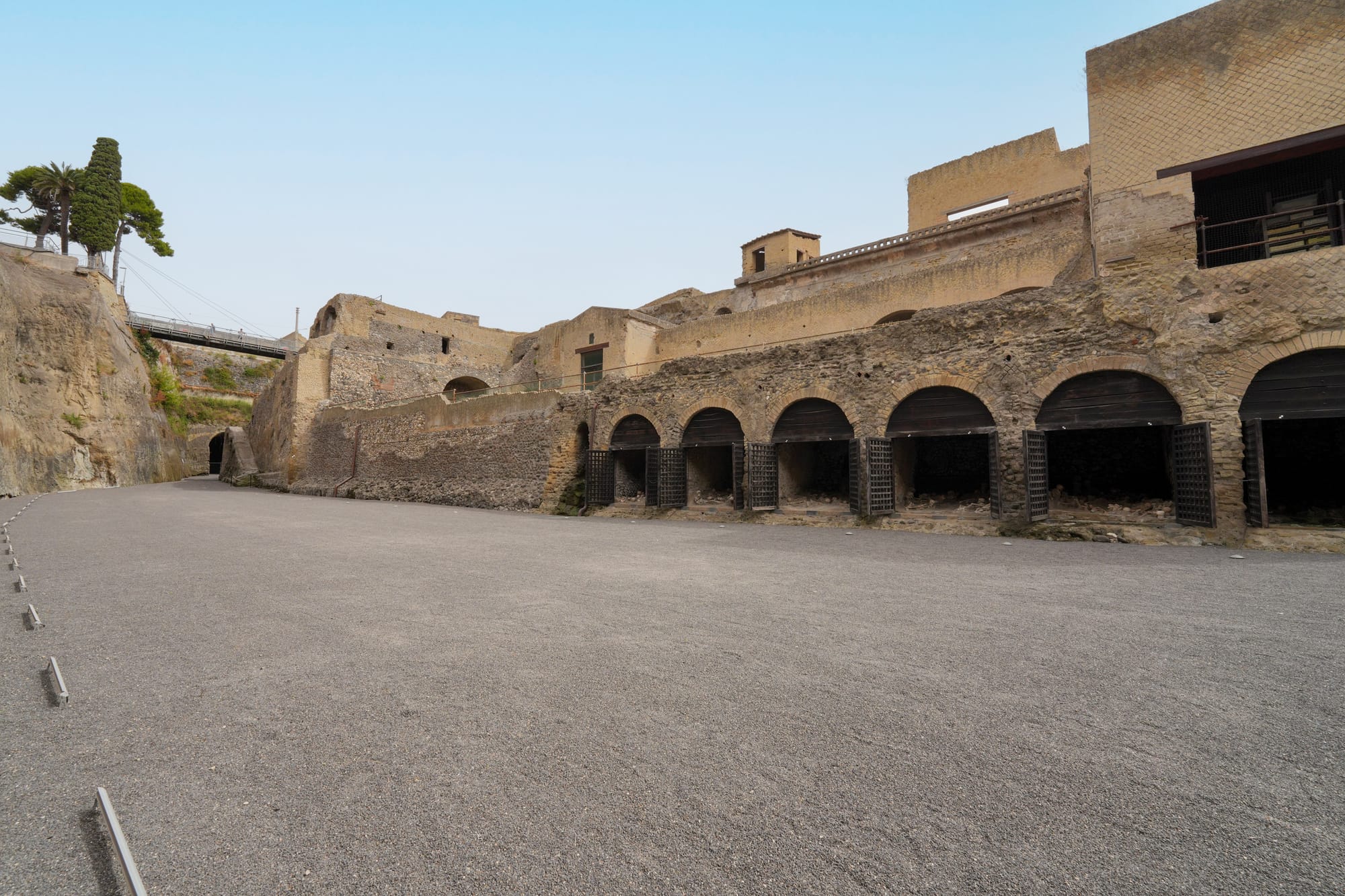
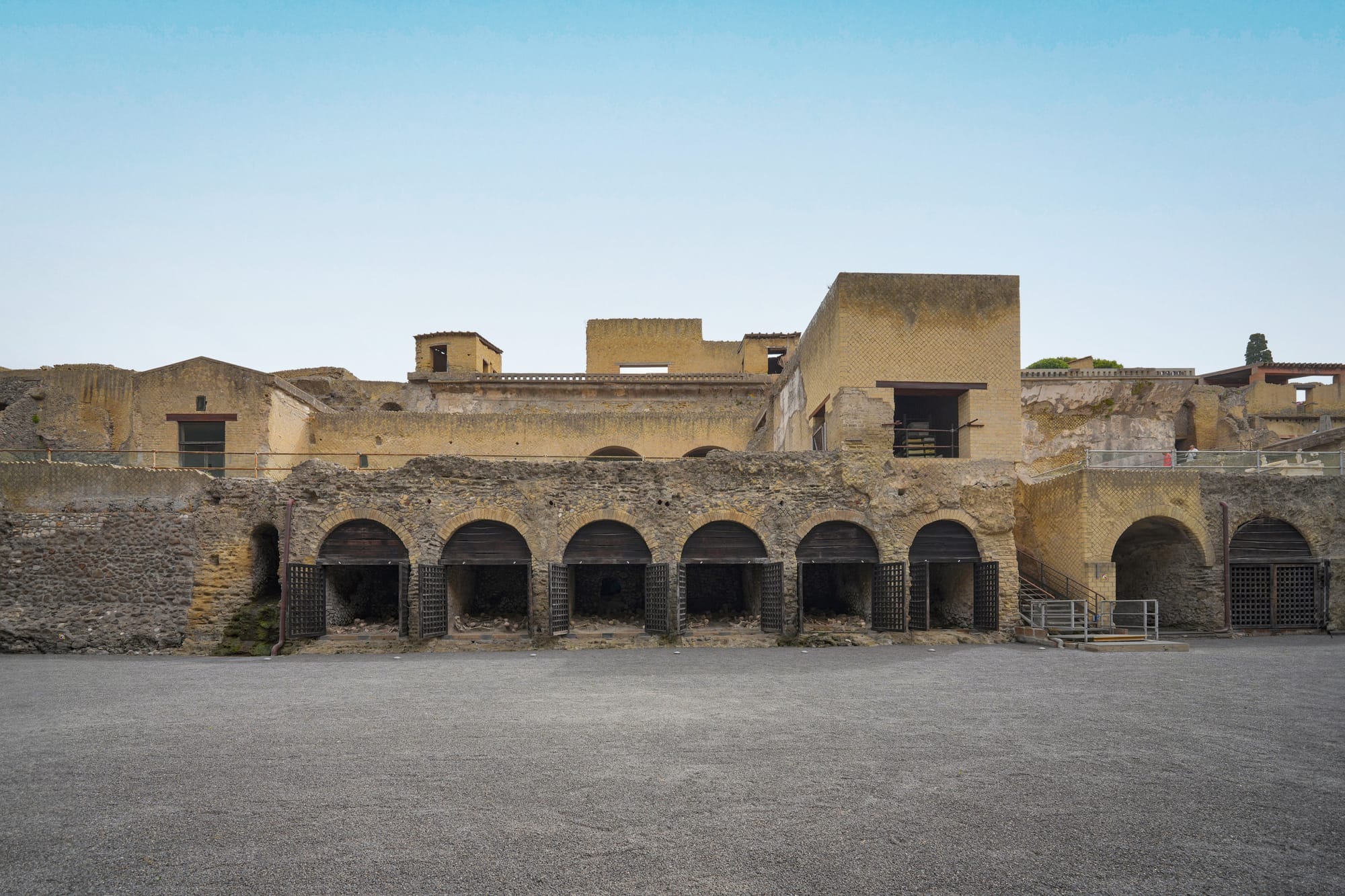
The Herculaneum Beach as it is now. Credits: Emanuele Antonio Minerva ‐ Ministero della Cultura
Visitor Experience: Walking Through History
Today, visitors to the Archaeological Park of Herculaneum can stroll along the ancient beach, tracing the steps of Roman citizens who lived nearly two millennia ago. This transformation not only enhances the visitor experience but also deepens the educational value of the site. The beach serves as a tangible link to the past, offering a powerful narrative of life, disaster, and preservation.
The reopening of Herculaneum’s ancient beach marks a significant achievement in cultural heritage preservation. It is a testament to the dedication and collaboration of numerous professionals and organizations committed to safeguarding and celebrating our shared history. As visitors walk along the restored shoreline, they are not just witnessing a historical site; they are engaging with the living legacy of an ancient civilization, brought to life through meticulous and passionate conservation efforts.

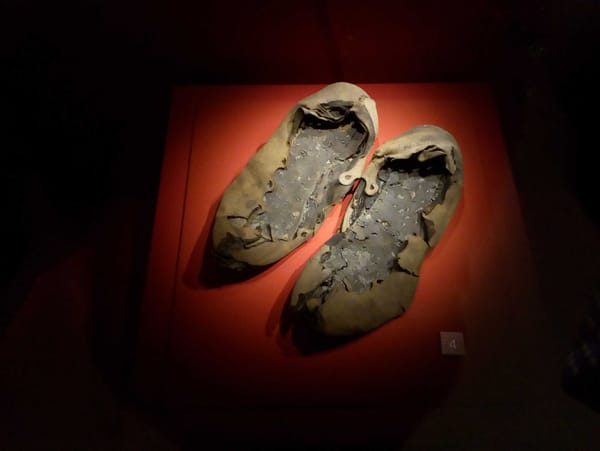

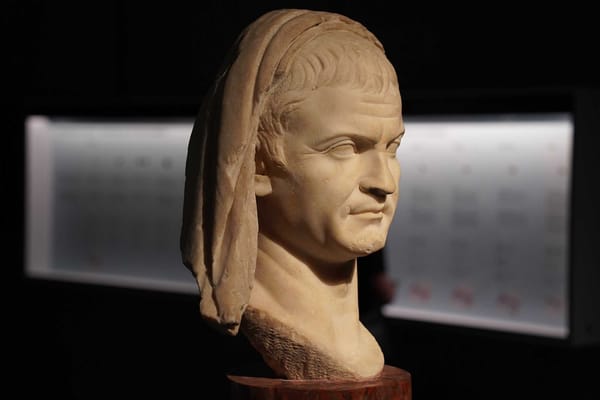

About the Roman Empire Times
See all the latest news for the Roman Empire, ancient Roman historical facts, anecdotes from Roman Times and stories from the Empire at romanempiretimes.com. Contact our newsroom to report an update or send your story, photos and videos. Follow RET on Google News, Flipboard and subscribe here to our daily email.
Follow the Roman Empire Times on social media: